

经典论文复现 | 基于标注策略的实体和关系联合抽取
source link: https://my.oschina.net/u/4067628/blog/4827215
Go to the source link to view the article. You can view the picture content, updated content and better typesetting reading experience. If the link is broken, please click the button below to view the snapshot at that time.

过去几年发表于各大 AI 顶会论文提出的 400 多种算法中,公开算法代码的仅占 6%,其中三分之一的论文作者分享了测试数据,约 54% 的分享包含“伪代码”。这是今年 AAAI 会议上一个严峻的报告。 人工智能这个蓬勃发展的领域正面临着实验重现的危机,就像实验重现问题过去十年来一直困扰着心理学、医学以及其他领域一样。最根本的问题是研究人员通常不共享他们的源代码。
可验证的知识是科学的基础,它事关理解。随着人工智能领域的发展,打破不可复现性将是必要的。为此,PaperWeekly 联手百度 PaddlePaddle 共同发起了本次论文有奖复现,我们希望和来自学界、工业界的研究者一起接力,为 AI 行业带来良性循环。
作者丨戴一鸣
学校丨清华海峡研究院
研究方向丨自然语言处理
下载安装命令 ## CPU版本安装命令 pip install -f https://paddlepaddle.org.cn/pip/oschina/cpu paddlepaddle ## GPU版本安装命令 pip install -f https://paddlepaddle.org.cn/pip/oschina/gpu paddlepaddle-gpu
笔者本次复现的是中科院自动化所发表于 ACL 2017 的经典文章——Joint Extraction of Entities and Relations Based on a Novel Tagging Scheme。

对于实体和关系的联合抽取一直是信息抽取中重要的任务。为了解决这一问题,论文提出了一个新型的标注方式,可以解决联合信息抽取中的标注问题。随后,基于这一标注方法,论文研究了不同的端到端模型,在不需要分开识别实体和关系的同时,直接抽取实体和实体之间的关系。
论文在使用了远程监督制作的公开数据集上进行了实验,结果说明这一标注策略较现有的管道和联合学习方法。此外,论文所提出的端到端模型在公开数据集上取得了目前最好的效果。
论文复现代码:
http://aistudio.baidu.com/aistudio/#/projectdetail/26338
论文提出了一个新型的标注方式,并设计了一个带有偏置(Bias)目标函数的端到端模型,去联合抽取实体和实体间的关系。
标注方式
图 1 是一个如何将原始标注数据(实体+实体关系)转换为论文中提到的新型标注方式的示例。在数据中,每一个词汇会被赋予一个实体标签,因此通过抽取和实体有关的词语,构成实体。

▲ 图1. 一个构成实体和关系的数据实例
第一个标签是“O”,表示这个词属于“Other”标签,词语不在被抽取结果中。除了标签“O”以外,其他标签都由三部分组成:1)词语在实体中的位置,2)实体关系类型,3)关系角色。
论文使用“BIES”规则(B:实体起始,I:实体内部,E:实体结束,S:单一实体)去标注词语在实体中的位置信息。对于实体关系类型,则通过预先定义的关系集合确定。对于关系角色,论文使用“1”和“2”确定。一个被抽取的实体关系结果由一个三元组表示(实体 1-关系类型-实体 2)。“1”表示这个词语属于第一个实体,“2”则表示这个词语属于第二个实体。因此,标签总数是:Nt = 2*4 *|R|+1。R 是预先定义好的关系类型的数量。
从图 1 可以看出,输入的句子包含两个三元组:
{United States, Country-President, Trump}
{Apple Inc, Company-Founder, Steven Paul Jobs}
预先定义的两组关系是:
Country-President: CP
Company-Founder:CF
由于“United”,“States”,“ Trump”,“Apple”,“Inc” ,“Steven”, “Paul”, “Jobs”构成了描述实体的词汇,因此这些词语都被赋予了特定的标记。
例如,“United”是实体“United States”的第一个词语,同时也和“Country-President”关联,因此“United”词语的标注是“B-CP-1”。“B”表示Begin,“CP”表示Country President,“1”表示“United”词语所在的实体“United States”是三元组中的第一个对象。
同理,因为“States”是“United States”实体的结尾词语,但依然属于“Country President”关系,同时也是三元组的第一个对象,因此“States”的标注是“E-CP-1”。
对于另一个词语“Trump”,它是构成“Trump”这一实体的唯一词语,因此使用“S”。同时,Trump 实体属于“Country President”关系,因此它具有CP标签,又同时这一实体在三元组中是第二个对象,因此它被标注“2”。综上,“Trump”这一词语的标注是:“S-CP-2”。除了这些和实体有关的词语外,无关词语被标注“O”。
当然,对于拥有两个和两个以上实体的句子,论文将每两个实体构成一个三元组,并使用最小距离原则(距离最近的两个实体构成一对关系)。在图 1 中,“United States”和“Trump”因为最小距离构成了一对实体。此外,论文只探讨一对一关系三元组。
端到端模型
双向长短时编码层(Bi-LSTM Encoder Layer)
在序列标注问题中,双向长短时编码器体现了对单个词语的语义信息的良好捕捉。这一编码器有一个前向和后向的长短时层,并在末尾将两层合并。词嵌入层则将词语的独热编码(1-hot representation)转换为词嵌入的向量。
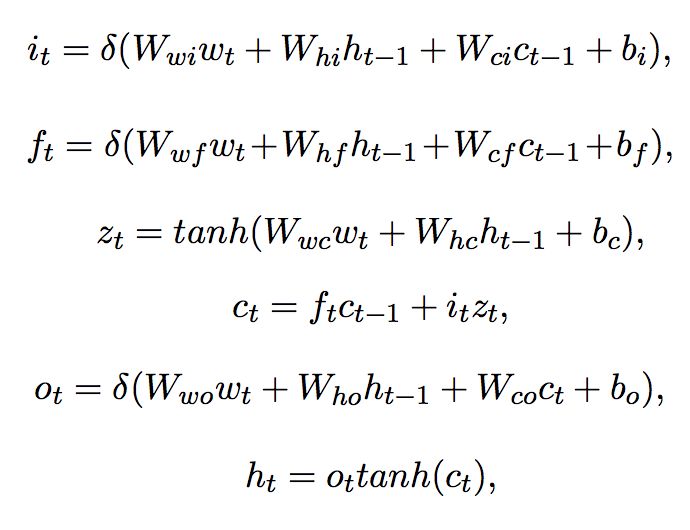
▲ 公式1. 双向长短时编码器
公式 1 中的 i,f 和 o 分别为 LSTM 模块在 t 时刻的输入门,遗忘门和输出门。c 为 LSTM 模块的输出,W 为权重。对于当前时刻,其隐层向量 的结果取决于起义时刻的
的结果取决于起义时刻的 ,上一时刻的
,上一时刻的 ,以及当前时刻的输入词语
,以及当前时刻的输入词语 。
。
对于一句话,表示为 。其中
。其中 是第 d 维度下在第 t 个词汇的词向量,n 则是句序列的长度。在经过了词嵌入后,前向和后向的长短时神经网络分布接受数据输入,前向则句子顺序从前向后,后向则从后向前。
是第 d 维度下在第 t 个词汇的词向量,n 则是句序列的长度。在经过了词嵌入后,前向和后向的长短时神经网络分布接受数据输入,前向则句子顺序从前向后,后向则从后向前。
对于每一个词语向量(经过词嵌入后) , 前向长短时神经网络层通过考虑语义信息,将
, 前向长短时神经网络层通过考虑语义信息,将 到
到 的信息全部编码,记为
的信息全部编码,记为 。同样,后向长短时则为
。同样,后向长短时则为 。编码器最后将两个层的输入相接。
。编码器最后将两个层的输入相接。
长短时解码器
论文同时使用了长短时解码器用于标注给定序列。解码器在当前时刻的输入为来自双向编码器的隐层向量 ,前一个预测的标签的嵌入
,前一个预测的标签的嵌入 ,前一个时刻的神经元输入
,前一个时刻的神经元输入 ,以及前一时刻的隐层向量
,以及前一时刻的隐层向量 。解码器根据双向长短时编码器的输出进行计算。解码器的内部公式类似于公式 1。
。解码器根据双向长短时编码器的输出进行计算。解码器的内部公式类似于公式 1。

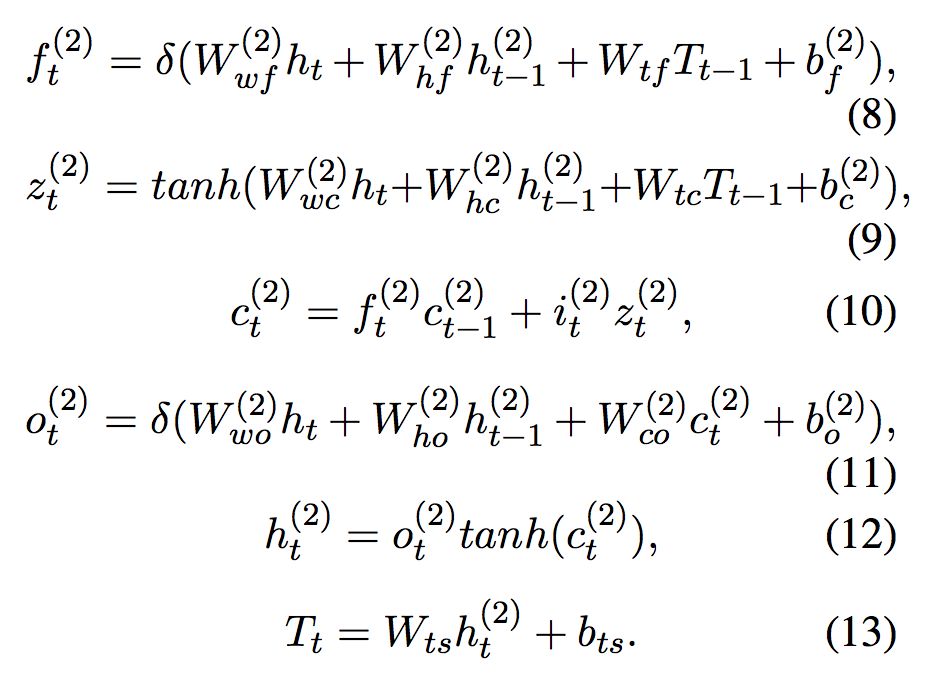
▲ 公式2. 长短时解码器
Softmax层
在解码器后加入 softmax 层,预测该词语的标签。解码器的内部结构类似于编码器。
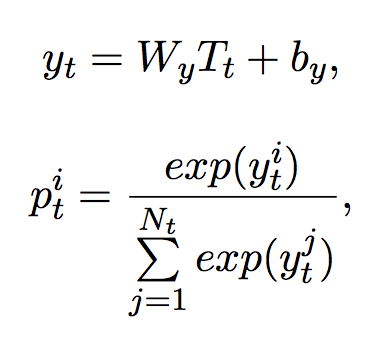
▲ 公式3. softmax层
 为 softmax 矩阵,
为 softmax 矩阵, 为总标签数,
为总标签数, 为预测标签的向量。
为预测标签的向量。
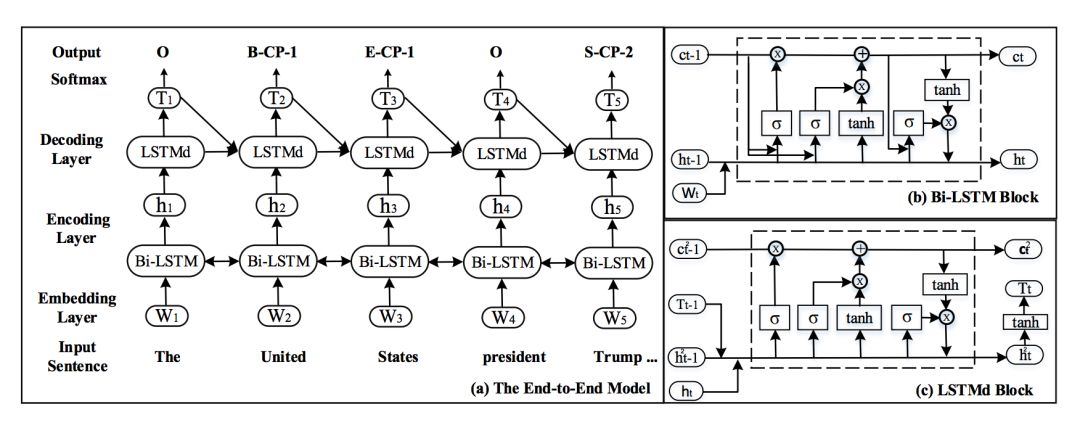
▲ 图2. 网络整体结构图
偏置目标函数(Bias Objective Function)

▲ 公式4. 训练中激活函数使用RMSprop
|D| 是训练集大小, 是句子
是句子 的长度,
的长度, 是词语 t 在
是词语 t 在 的标签,
的标签, 是归一化的 tag 的概率。I(O) 是一个条件函数(switching function),用于区分 tag 为“O”和不为“O”的时候的损失。
是归一化的 tag 的概率。I(O) 是一个条件函数(switching function),用于区分 tag 为“O”和不为“O”的时候的损失。

▲ 公式5. 条件函数
α 是偏置权重,该项越大,则带关系的标签对模型的影响越大。
import paddle.fluid as fluidimport paddle.v2 as paddlefrom paddle.fluid.initializer import NormalInitializerimport reimport math#coding='utf-8'import jsonimport numpy as npfrom paddle.v2.plot import Plotertrain_title = "Train cost"test_title = "Test cost"plot_cost = Ploter(train_title, test_title)step = 0#=============================================global parameters and hyperparameters==================================EMBEDDING = 300DROPOUT = 0.5LSTM_ENCODE = 300LSTM_DECODE = 600BIAS_ALPHA = 10VALIDATION_SIZE = 0.1TRAIN_PATH = '/home/aistudio/data/data1272/train.json'TEST_PATH = '/home/aistudio/data/data1272/test.json'FILE_PATH = '/home/aistudio/data/'X_TRAIN = '/home/aistudio/data/data1272/sentence_train.txt'Y_TRAIN = '/home/aistudio/data/data1272/seq_train.txt'X_TEST = '/home/aistudio/data/data1272/sentence_test.txt'Y_TEST = '/home/aistudio/data/data1272/seq_test.txt'WORD_DICT = '/home/aistudio/data/data1272/word_dict.txt'TAG_DICT = '/home/aistudio/data/data1272/tag_dict.txt'EPOCH_NUM = 1000BATCH_SIZE = 128#=============================================get data from the dataset==============================================def get_data(train_path, test_path, train_valid_size): ''' extracting data for json file ''' train_file = open(train_path).readlines() x_train = [] y_train = [] for i in train_file: data = json.loads(i) x_data, y_data = data_decoding(data) ''' appending each single data into the x_train/y_train sets ''' x_train += x_data y_train += y_data test_file = open(test_path).readlines() x_test = [] y_test = [] for j in test_file: data = json.loads(j) x_data, y_data = data_decoding(data) x_test += x_data y_test += y_data return x_train, y_train, x_test, y_testdef data_decoding(data): ''' decode the json file sentText is the sentence each sentence may have multiple types of relations for every single data, it contains: (sentence-splited, labels) ''' sentence = data["sentText"] relations = data["relationMentions"] x_data = [] y_data = [] for i in relations: entity_1 = i["em1Text"].split(" ") entity_2 = i["em2Text"].split(" ") relation = i["label"] relation_label_1 = entity_label_construction(entity_1) relation_label_2 = entity_label_construction(entity_2) output_list = sentence_label_construction(sentence, relation_label_1, relation_label_2, relation) x_data.append(sentence.split(" ")) y_data.append(output_list) return x_data, y_datadef entity_label_construction(entity): ''' give each word in an entity the label for entity with multiple words, it should follow the BIES rule ''' relation_label = {} for i in range(len(entity)): if i == 0 and len(entity) >= 1: relation_label[entity[i]] = "B" if i != 0 and len(entity) >= 1 and i != len(entity) -1: relation_label[entity[i]] = "I" if i== len(entity) -1 and len(entity) >= 1: relation_label[entity[i]] = "E" if i ==0 and len(entity) == 1: relation_label[entity[i]] = "S" return relation_labeldef sentence_label_construction(sentence, relation_label_1, relation_label_2, relation): ''' combine the label for each word in each entity with the relation and then combine the relation-entity label with the position of the entity in the triplet ''' element_list = sentence.split(" ") dlist_1 = list(relation_label_1) dlist_2 = list(relation_label_2) output_list = [] for i in element_list: if i in dlist_1: output_list.append(relation + '-' + relation_label_1[i] + '-1' ) elif i in dlist_2: output_list.append(relation + '-' + relation_label_2[i] + '-2') else: output_list.append('O') return output_listdef format_control(string): str1 = re.sub(r'\r','',string) str2 = re.sub(r'\n','',str1) str3 = re.sub(r'\s*','',str2) return str3def joint_extraction(): vocab_size = len(open(WORD_DICT,'r').readlines()) tag_num = len(open(TAG_DICT,'r').readlines()) def bilstm_lstm(word, target, vocab_size, tag_num): x = fluid.layers.embedding( input = word, size = [vocab_size, EMBEDDING], dtype = "float32", is_sparse = True) y = fluid.layers.embedding( input = target, size = [tag_num, tag_num], dtype = "float32", is_sparse = True) fw, _ = fluid.layers.dynamic_lstm( input = fluid.layers.fc(size = LSTM_ENCODE*4, input=x), size = LSTM_ENCODE*4, candidate_activation = "tanh", gate_activation = "sigmoid", cell_activation = "sigmoid", bias_attr=fluid.ParamAttr( initializer=NormalInitializer(loc=0.0, scale=1.0)), is_reverse = False) bw, _ = fluid.layers.dynamic_lstm( input = fluid.layers.fc(size = LSTM_ENCODE*4, input=x), size = LSTM_ENCODE*4, candidate_activation = "tanh", gate_activation = "sigmoid", cell_activation = "sigmoid", bias_attr=fluid.ParamAttr( initializer=NormalInitializer(loc=0.0, scale=1.0)), is_reverse = True) combine = fluid.layers.concat([fw,bw], axis=1) decode, _ = fluid.layers.dynamic_lstm( input = fluid.layers.fc(size = LSTM_DECODE*4, input=combine), size = LSTM_DECODE*4, candidate_activation = "tanh", gate_activation = "sigmoid", cell_activation = "sigmoid", bias_attr=fluid.ParamAttr( initializer=NormalInitializer(loc=0.0, scale=1.0)), is_reverse = False) softmax_connect = fluid.layers.fc(input=decode, size=tag_num) _cost = fluid.layers.softmax_with_cross_entropy( logits=softmax_connect, label = y, soft_label = True) _loss = fluid.layers.mean(x=_cost) return _loss, softmax_connect source = fluid.layers.data(name="source", shape=[1], dtype="int64", lod_level=1) target = fluid.layers.data(name="target", shape=[1], dtype="int64", lod_level=1) loss, softmax_connect = bilstm_lstm(source, target, vocab_size, tag_num) return lossdef get_index(word_dict, tag_dict, x_data, y_data): x_out = [word_dict[str(k)] for k in x_data] y_out = [tag_dict[str(l)] for l in y_data] return [x_out, y_out]def data2index(WORD_DICT, TAG_DICT, x_train, y_train): def _out_dict(word_dict_path, tag_dict_path): word_dict = {} f = open(word_dict_path,'r').readlines() for i, j in enumerate(f): word = re.sub(r'\n','',str(j))# word = re.sub(r'\r','',str(j))# word = re.sub(r'\s*','',str(j)) word_dict[word] = i + 1 tag_dict = {} f = open(tag_dict_path,'r').readlines() for m,n in enumerate(f): tag = re.sub(r'\n','',str(n)) tag_dict[tag] = m+1 return word_dict, tag_dict def _out_data(): word_dict, tag_dict = _out_dict(WORD_DICT, TAG_DICT) for data in list(zip(x_train, y_train)): x_out, y_out = get_index(word_dict, tag_dict, data[0], data[1]) yield x_out, y_out return _out_datadef optimizer_program(): return fluid.optimizer.Adam()if __name__ == "__main__": sentence_train, seq_train, sentence_test, seq_test = get_data(TRAIN_PATH,TEST_PATH,VALIDATION_SIZE) train_reader = paddle.batch( paddle.reader.shuffle( data2index(WORD_DICT, TAG_DICT, sentence_train, seq_train), buf_size=500), batch_size=128) test_reader = paddle.batch( paddle.reader.shuffle( data2index(WORD_DICT, TAG_DICT, sentence_test, seq_test), buf_size=500), batch_size=128) place = fluid.CPUPlace() feed_order=['source', 'target'] trainer = fluid.Trainer( train_func=joint_extraction, place=place, optimizer_func = optimizer_program) trainer.train( reader=train_reader, num_epochs=100, event_handler=event_handler_plot, feed_order=feed_order)as fluid
import paddle.v2 as paddle
from paddle.fluid.initializer import NormalInitializer
import re
import math
#coding='utf-8'
import json
import numpy as np
from paddle.v2.plot import Ploter
train_title = "Train cost"
test_title = "Test cost"
plot_cost = Ploter(train_title, test_title)
step = 0
#=============================================global parameters and hyperparameters==================================
EMBEDDING = 300
DROPOUT = 0.5
LSTM_ENCODE = 300
LSTM_DECODE = 600
BIAS_ALPHA = 10
VALIDATION_SIZE = 0.1
TRAIN_PATH = '/home/aistudio/data/data1272/train.json'
TEST_PATH = '/home/aistudio/data/data1272/test.json'
FILE_PATH = '/home/aistudio/data/'
X_TRAIN = '/home/aistudio/data/data1272/sentence_train.txt'
Y_TRAIN = '/home/aistudio/data/data1272/seq_train.txt'
X_TEST = '/home/aistudio/data/data1272/sentence_test.txt'
Y_TEST = '/home/aistudio/data/data1272/seq_test.txt'
WORD_DICT = '/home/aistudio/data/data1272/word_dict.txt'
TAG_DICT = '/home/aistudio/data/data1272/tag_dict.txt'
EPOCH_NUM = 1000
BATCH_SIZE = 128
#=============================================get data from the dataset==============================================
def get_data(train_path, test_path, train_valid_size):
'''
extracting data for json file
'''
train_file = open(train_path).readlines()
x_train = []
y_train = []
for i in train_file:
data = json.loads(i)
x_data, y_data = data_decoding(data)
'''
appending each single data into the x_train/y_train sets
'''
x_train += x_data
y_train += y_data
test_file = open(test_path).readlines()
x_test = []
y_test = []
for j in test_file:
data = json.loads(j)
x_data, y_data = data_decoding(data)
x_test += x_data
y_test += y_data
return x_train, y_train, x_test, y_test
def data_decoding(data):
'''
decode the json file
sentText is the sentence
each sentence may have multiple types of relations
for every single data, it contains: (sentence-splited, labels)
'''
sentence = data["sentText"]
relations = data["relationMentions"]
x_data = []
y_data = []
for i in relations:
entity_1 = i["em1Text"].split(" ")
entity_2 = i["em2Text"].split(" ")
relation = i["label"]
relation_label_1 = entity_label_construction(entity_1)
relation_label_2 = entity_label_construction(entity_2)
output_list = sentence_label_construction(sentence, relation_label_1, relation_label_2, relation)
x_data.append(sentence.split(" "))
y_data.append(output_list)
return x_data, y_data
def entity_label_construction(entity):
'''
give each word in an entity the label
for entity with multiple words, it should follow the BIES rule
'''
relation_label = {}
for i in range(len(entity)):
if i == 0 and len(entity) >= 1:
relation_label[entity[i]] = "B"
if i != 0 and len(entity) >= 1 and i != len(entity) -1:
relation_label[entity[i]] = "I"
if i== len(entity) -1 and len(entity) >= 1:
relation_label[entity[i]] = "E"
if i ==0 and len(entity) == 1:
relation_label[entity[i]] = "S"
return relation_label
def sentence_label_construction(sentence, relation_label_1, relation_label_2, relation):
'''
combine the label for each word in each entity with the relation
and then combine the relation-entity label with the position of the entity in the triplet
'''
element_list = sentence.split(" ")
dlist_1 = list(relation_label_1)
dlist_2 = list(relation_label_2)
output_list = []
for i in element_list:
if i in dlist_1:
output_list.append(relation + '-' + relation_label_1[i] + '-1' )
elif i in dlist_2:
output_list.append(relation + '-' + relation_label_2[i] + '-2')
else:
output_list.append('O')
return output_list
def format_control(string):
str1 = re.sub(r'\r','',string)
str2 = re.sub(r'\n','',str1)
str3 = re.sub(r'\s*','',str2)
return str3
def joint_extraction():
vocab_size = len(open(WORD_DICT,'r').readlines())
tag_num = len(open(TAG_DICT,'r').readlines())
def bilstm_lstm(word, target, vocab_size, tag_num):
x = fluid.layers.embedding(
input = word,
size = [vocab_size, EMBEDDING],
dtype = "float32",
is_sparse = True)
y = fluid.layers.embedding(
input = target,
size = [tag_num, tag_num],
dtype = "float32",
is_sparse = True)
fw, _ = fluid.layers.dynamic_lstm(
input = fluid.layers.fc(size = LSTM_ENCODE*4, input=x),
size = LSTM_ENCODE*4,
candidate_activation = "tanh",
gate_activation = "sigmoid",
cell_activation = "sigmoid",
bias_attr=fluid.ParamAttr(
initializer=NormalInitializer(loc=0.0, scale=1.0)),
is_reverse = False)
bw, _ = fluid.layers.dynamic_lstm(
input = fluid.layers.fc(size = LSTM_ENCODE*4, input=x),
size = LSTM_ENCODE*4,
candidate_activation = "tanh",
gate_activation = "sigmoid",
cell_activation = "sigmoid",
bias_attr=fluid.ParamAttr(
initializer=NormalInitializer(loc=0.0, scale=1.0)),
is_reverse = True)
combine = fluid.layers.concat([fw,bw], axis=1)
decode, _ = fluid.layers.dynamic_lstm(
input = fluid.layers.fc(size = LSTM_DECODE*4, input=combine),
size = LSTM_DECODE*4,
candidate_activation = "tanh",
gate_activation = "sigmoid",
cell_activation = "sigmoid",
bias_attr=fluid.ParamAttr(
initializer=NormalInitializer(loc=0.0, scale=1.0)),
is_reverse = False)
softmax_connect = fluid.layers.fc(input=decode, size=tag_num)
_cost = fluid.layers.softmax_with_cross_entropy(
logits=softmax_connect,
label = y,
soft_label = True)
_loss = fluid.layers.mean(x=_cost)
return _loss, softmax_connect
source = fluid.layers.data(name="source", shape=[1], dtype="int64", lod_level=1)
target = fluid.layers.data(name="target", shape=[1], dtype="int64", lod_level=1)
loss, softmax_connect = bilstm_lstm(source, target, vocab_size, tag_num)
return loss
def get_index(word_dict, tag_dict, x_data, y_data):
x_out = [word_dict[str(k)] for k in x_data]
y_out = [tag_dict[str(l)] for l in y_data]
return [x_out, y_out]
def data2index(WORD_DICT, TAG_DICT, x_train, y_train):
def _out_dict(word_dict_path, tag_dict_path):
word_dict = {}
f = open(word_dict_path,'r').readlines()
for i, j in enumerate(f):
word = re.sub(r'\n','',str(j))
# word = re.sub(r'\r','',str(j))
# word = re.sub(r'\s*','',str(j))
word_dict[word] = i + 1
tag_dict = {}
f = open(tag_dict_path,'r').readlines()
for m,n in enumerate(f):
tag = re.sub(r'\n','',str(n))
tag_dict[tag] = m+1
return word_dict, tag_dict
def _out_data():
word_dict, tag_dict = _out_dict(WORD_DICT, TAG_DICT)
for data in list(zip(x_train, y_train)):
x_out, y_out = get_index(word_dict, tag_dict, data[0], data[1])
yield x_out, y_out
return _out_data
def optimizer_program():
return fluid.optimizer.Adam()
if __name__ == "__main__":
sentence_train, seq_train, sentence_test, seq_test = get_data(TRAIN_PATH,TEST_PATH,VALIDATION_SIZE)
train_reader = paddle.batch(
paddle.reader.shuffle(
data2index(WORD_DICT, TAG_DICT, sentence_train, seq_train),
buf_size=500),
batch_size=128)
test_reader = paddle.batch(
paddle.reader.shuffle(
data2index(WORD_DICT, TAG_DICT, sentence_test, seq_test),
buf_size=500),
batch_size=128)
place = fluid.CPUPlace()
feed_order=['source', 'target']
trainer = fluid.Trainer(
train_func=joint_extraction,
place=place,
optimizer_func = optimizer_program)
trainer.train(
reader=train_reader,
num_epochs=100,
event_handler=event_handler_plot,
feed_order=feed_order)
▲ 模型和运行函数train代码展示
实验设置
数据集
使用 NYT 公开数据集。大量数据通过远程监督的方式提取。测试集则使用了人工标注的方式。训练集总共有 353k 的三元组,测试集有 3880 个。此外,预定义的关系数量为 24 个。
评价方式
采用标准的精确率(Precision)和召回率(Recall)以及 F1 分数对结果进行评价。当三元组中的实体 1,实体 2,以及关系的抽取均正确才可记为 True。10% 的数据用于验证集,且实验进行了 10 次,结果取平均值和标准差。
超参数
词嵌入使用 word2vec,词嵌入向量是 300 维。论文对嵌入层进行了正则化,其 dropout 概率为 0.5。长短时编码器的长短时神经元数量为 300,解码器为 600。偏置函数的权重 α 为 10。
论文和其他三元组抽取方法进行了对比,包括多项管道方法,联合抽取方法等。
实验结果
表 1 为实体和实体关系抽取的表现结果,本论文正式方法名称为“LSTM-LSTM-Bias”。表格前三项为管道方法,中间三项为联合抽取方法。
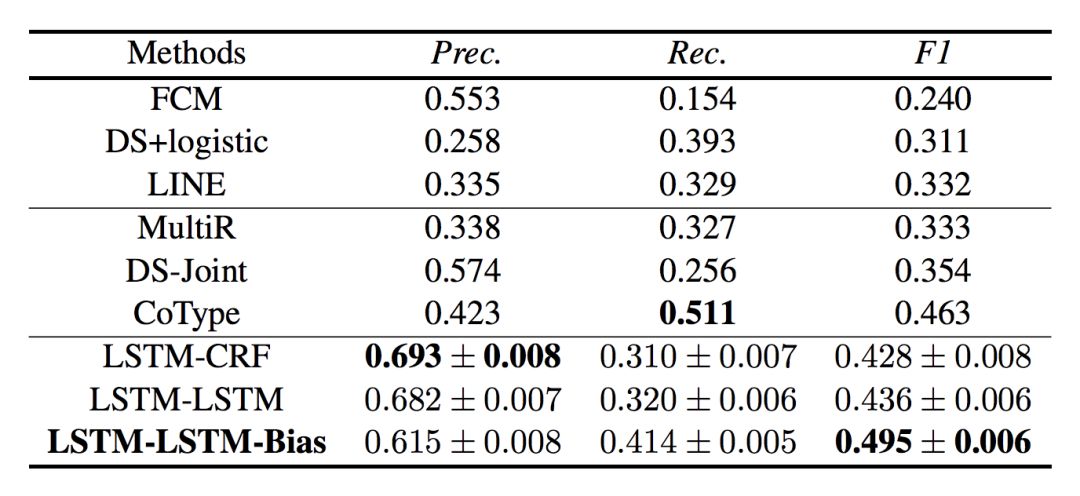
▲ 表1. 实体和实体关系抽取结果
从实验结果看出,论文提到的方法普遍优于管道方法和绝大多数联合抽取方法。本论文另一个值得注意的地方是,论文提出的方法较好地平衡了精确率和召回率的关系,尽管在精确率指标上略低于 LSTM-CRF。
表 1 也说明深度学习方法对三元组结果的抽取基本上好于传统方法。作者认为,这是因为深度学习方法在信息抽取中普遍使用双向长短时编码器,可以较好地编码语义信息。
在不同深度学习的表现对比中,作者发现,LSTM-LSTM 方法好于 LSTM-CRF。论文认为,这可能是因为 LSTM 较 CRF 更好地捕捉了文本中实体的较长依赖关系。
分析和讨论
错误分析
表 2 为深度学习方法对三元组各个元素的抽取效果对比,E1 表示实体 1 的抽取结果,E2 表示实体 2 的抽取结果,(E1,E2)表示实体的关系的抽取结果。

▲ 表2. 深度学习方法对三元组各元素抽取效果
表 2 说明,在对三元组实体的抽取中,对关系的抽取较三元组各个实体的抽取的精确率更好,但召回率更低。论文认为,这是由于有大量的实体抽取后未能组成合适的实体关系对。模型仅抽取了第一个实体 1,但未能找到合适的对应实体 2,或者仅有实体 2 被正确抽取出来。
此外,作者发现,表 2 的关系抽取结果比表 1 的结果提高了约 3%。作者认为,这是由于 3% 的结果预测错误是因为关系预测错误,而非实体预测错误导致的。
偏置损失分析
作者同时将论文方法和其他深度学习方法在识别单个实体(实体 1,实体 2)上的表现进行了对比。作者认为,虽然论文方法在识别单个实体上的表现低于其他方法,但能够更好地识别关系。
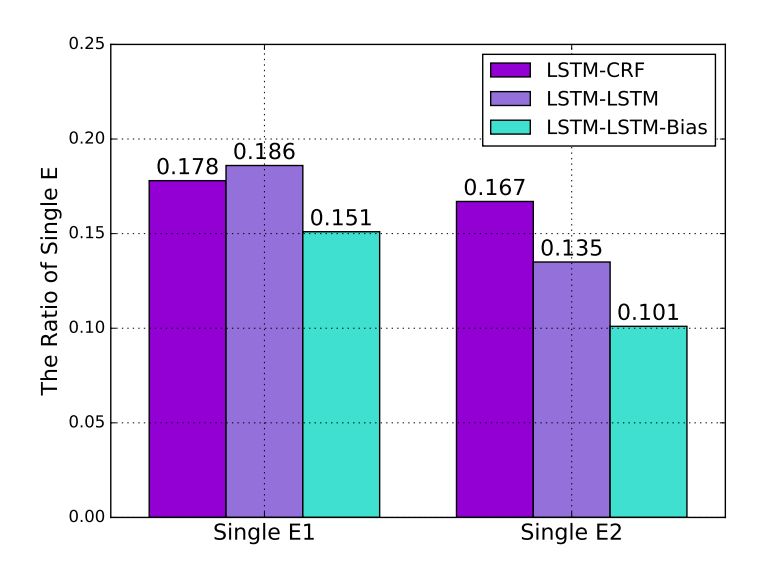
▲ 表3. 单个实体识别结果
作者对比发现,当偏置项等于 10 时,F1 数值最高。因此建议偏置项设为 10。
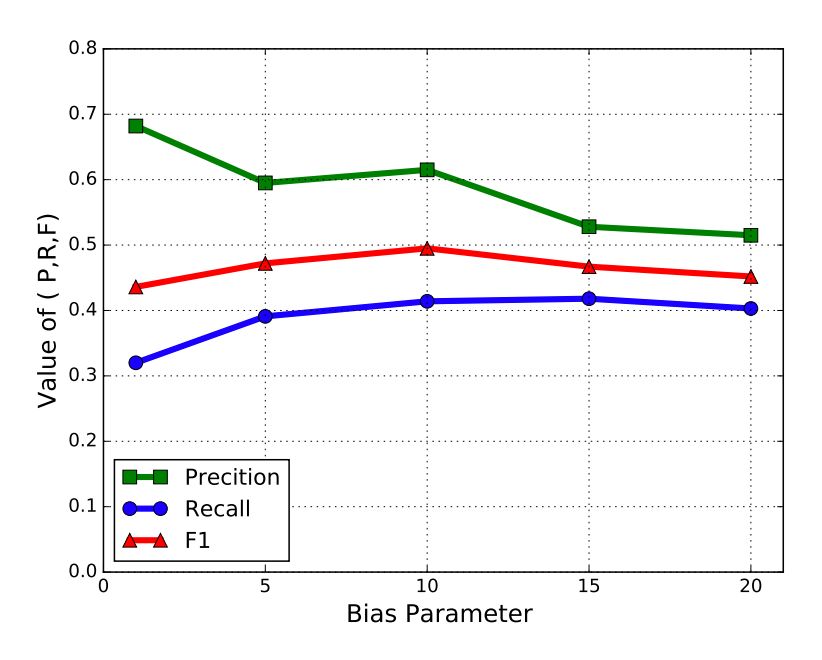
▲ 表4. 偏置项(α)数值和各项表现指标的关系
本文提出一种新型的标注方式,将传统的命名实体识别和关系抽取任务联合起来,使用端到端模型进行直接联合信息抽取。在和传统方法以及深度学习方法的对比中均取得了满意的成果。
考虑到目前论文设计的实体关系抽取仅限于单个的关系,无法对一句话中重合的多个实体关系进行抽取,论文作者考虑使用多分类器替换 softmax 层,以便对词语进行多分类标注。
关于PaddlePaddle
使用 PaddlePaddle 进行工作大体上感觉不错,优点主要有:
1. 构建模型的过程较为顺利
PaddlePaddle 的官方文档较为清楚,大量的函数和 TensorFlow 主流框架对应,因此在寻找组件的时候可以找到。
2. 运行速度快
据了解,PaddlePaddle 底层优化较好,速度比 TensorFlow 快很多。
3. 对 GPU 的支持
主流框架目前都支持了 GPU,PaddlePaddle 也同样具有这一特性。
4. 动态图架构
在数据更加复杂的情况下,动态图的构建优势比静态图更为明显。PaddlePaddle 框架下的 fluid 版本甚至比 TensorFlow 的动态图支持更领先。
当然,考虑到 PaddlePaddle 依然年轻,仍有不少问题需要进一步优化:
1. 在笔者使用的时候,仍然不支持 Python 3.x(2018 年 9 月)。据说在 11 月份会开始支持 Python 3.x,正在期待中。
2. Debug 仍然困难。可能一方面是因为笔者使用了 AI studio 而非传统的 IDE 进行项目,另一方面是 PaddlePaddle 内部的优化问题,代码出错的时候,很难找到问题原因。这一点和 TensorFlow 有点像——各种各样的报错。
接下来期待 PaddlePaddle 更加支持 TPU 和 NPU,并更好地增加对小型移动设备和物联网系统的支持,使模型可以无障碍部署。
下载安装命令 ## CPU版本安装命令 pip install -f https://paddlepaddle.org.cn/pip/oschina/cpu paddlepaddle ## GPU版本安装命令 pip install -f https://paddlepaddle.org.cn/pip/oschina/gpu paddlepaddle-gpu

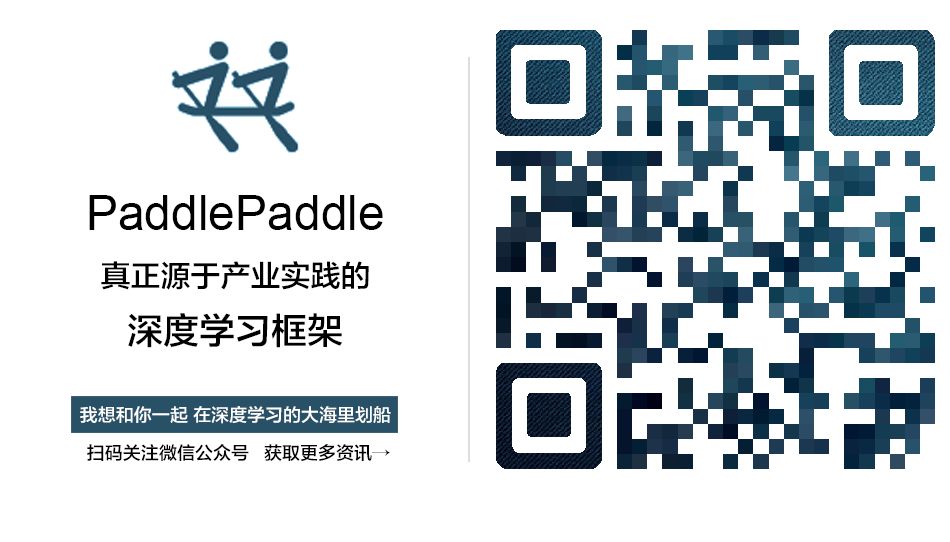
Recommend
About Joyk
Aggregate valuable and interesting links.
Joyk means Joy of geeK